Ugetsu: A Haunting Masterpiece by Kenji Mizoguchi
Kenji Mizoguchi, a name synonymous with cinematic mastery, was particularly revered by the critics of the “Cahiers du Cinéma” circle in France. His film, Ugetsu (also known as Ugetsu Monogatari), achieved remarkable recognition, tying for fourth place with Stroheim’s Greed in the prestigious “Greatest Films of All Time” poll conducted by Sight & Sound in 1962.
Despite this acclaim, only one of Mizoguchi’s works, Street of Shame, a poignant portrayal of geisha life, graced French commercial theaters, enjoying a six-month run. Now, six years after Mizoguchi’s passing, Ugetsu, arguably one of his most significant late-period films, has finally premiered in London, offering a valuable opportunity to delve deeper into his artistic genius.
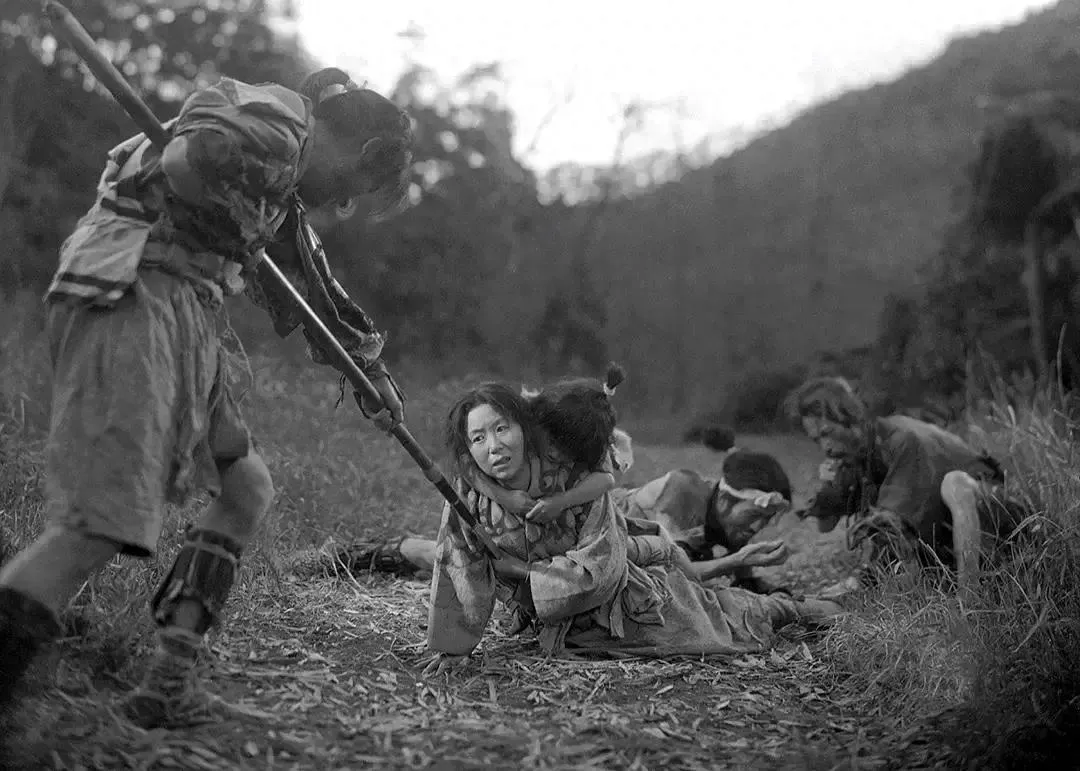
Ugetsu
A Journey into the Realm of Dreams and Nightmares
Ugetsu unfolds as an extraordinary essay, a mystical allegory that evokes the primal fears of childhood – the unsettling sound of wind whistling through chimneys or the creaking of doors in the dead of night. The narrative draws us into a dreamlike, enigmatic realm, characterized by mist-shrouded rivers, desolate villages, barren plains, and haunted castles. Nothing is quite as it seems. This is a land without maps, shifting and changing like a phantom within a castle. Peace is absent; a palpable sense of unease permeates the atmosphere, punctuated by the ominous sound of distant gunfire.
The ground feels as though it could give way at any moment, with mountains poised to erupt in flames. Figures like Shibata and Lord Nobunaga – “that terrible beast” – remain unseen forces, rarely glimpsed, yet their presence is felt through their retinues: the boorish samurai, bandits, and pirates who ravage the land and sea, violating women and plundering villages.
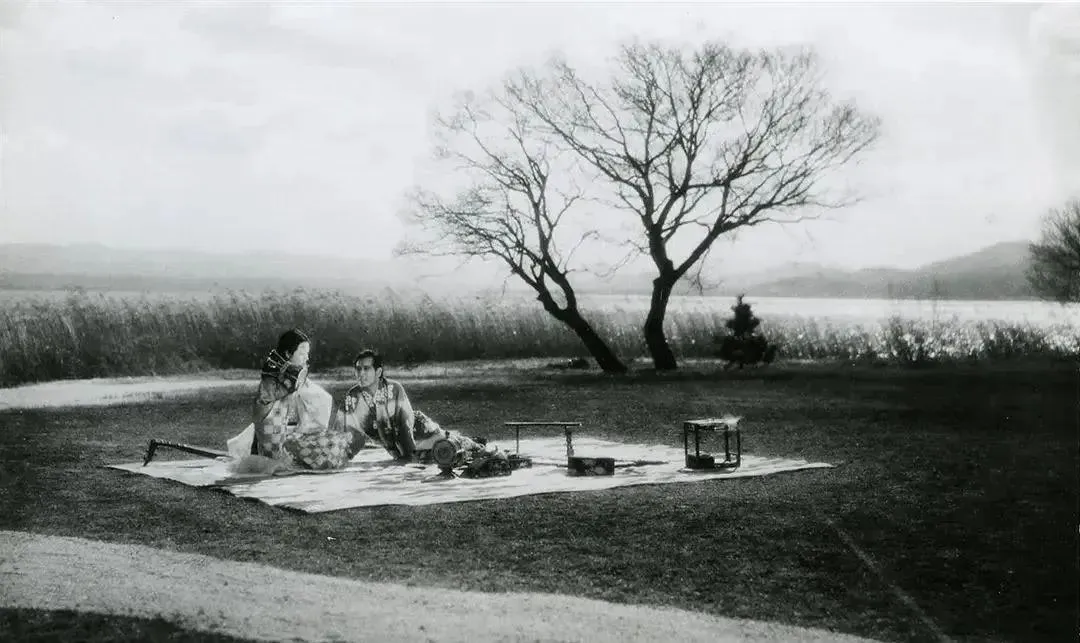
The Illusion of Tranquility
At the heart (or perhaps the edge) of this nightmarish world lies a seemingly tranquil haven: a village inhabited by two potters, Genjuro and his brother-in-law, Tobei. Despite their hardscrabble existence, their family lives are filled with warmth and contentment. Genjuro deeply loves his devoted wife, Miyagi, and their child, while Tobei shares a close bond with his wife, Ohama. Their labor in the fields provides them with meager possessions, sustaining their lives.
However, this sense of stability is soon revealed to be illusory, built upon a natural order that has been disrupted. Miyagi, the ideal wife, recognizes the insidious creep of war, while Genjuro begins to yearn for a different, more prosperous life. Miyagi implores her husband to accept their present circumstances and find happiness in their work.
In essence, Miyagi articulates the central theme of the film: the futility of human desires and their inevitable consequences. As the story unfolds, every character except her succumbs to the allure of external ambitions, paying a heavy price for their aspirations.
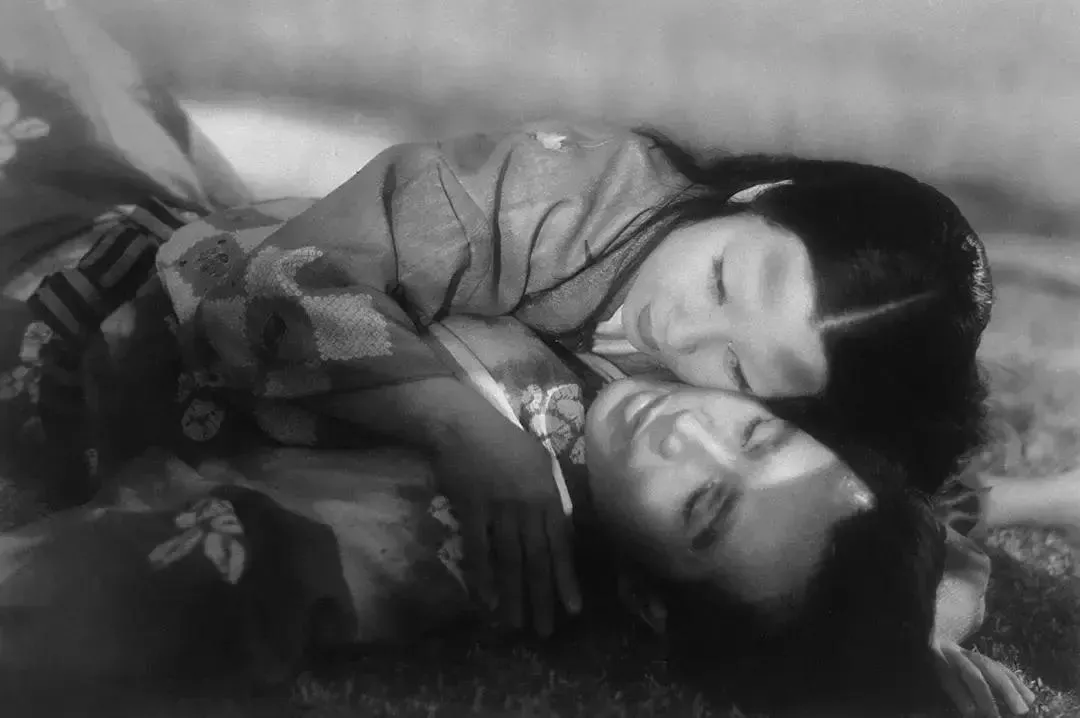
Disrupted Order and the River of Death
Marauders descend upon their humble dwelling. The potters’ families flee, leaving behind only their kiln. Everything is in flux; even their home, their source of stability, is as precarious and fragile as the human spirit. In a series of meticulously crafted scenes, Mizoguchi depicts the refugees fleeing their ravaged village. With his characteristic simplicity and precision, Mizoguchi first presents a static long shot of the villagers traversing the reeds from right to left, followed by a diagonal tracking shot of them huddled on a slope – a transition that sounds obvious but is executed with seamless mastery. As the marauders depart, the potters cautiously return, relieved to find their kiln intact.
This sequence serves as a silent exposition of Mizoguchi’s narrative: by establishing a pervasive sense of insecurity, both the soul and the natural world are thrown into disarray. It is the prologue to the unfolding drama. The potters, anxious about the fate of their kiln, hope to sell their wares. But how can they reach the town amidst such peril? Discovering a small canoe, they decide to navigate the lake.
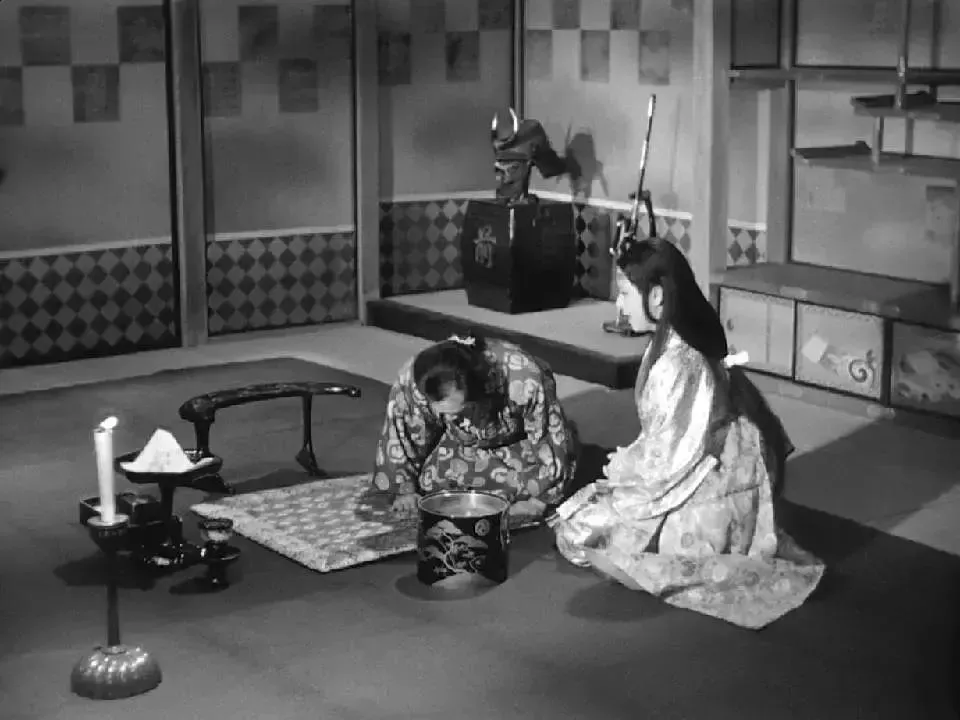
It is an eerie journey; the lake is so dark, shrouded in mist, and foreboding that the travelers might mistake it for the River Styx, the river of death. Unsurprisingly, when a boat drifts towards them through the fog, the potters believe it to be a ghost ship – they mistake the passengers for specters.
This sense of irony permeates Ugetsu; nothing is quite as it seems. The passengers are, in fact, all too human, having been brutally wounded by pirates. Before the boats separate, they warn the potters of the pirates who frequent these waters. Genjuro interprets this as an ill omen, and so leaves his wife and child on the shore, taking Tobei and Ohama with him to the market. Little does he know that this is a warning of the impending disintegration of his family, rather than a caution against pirates.
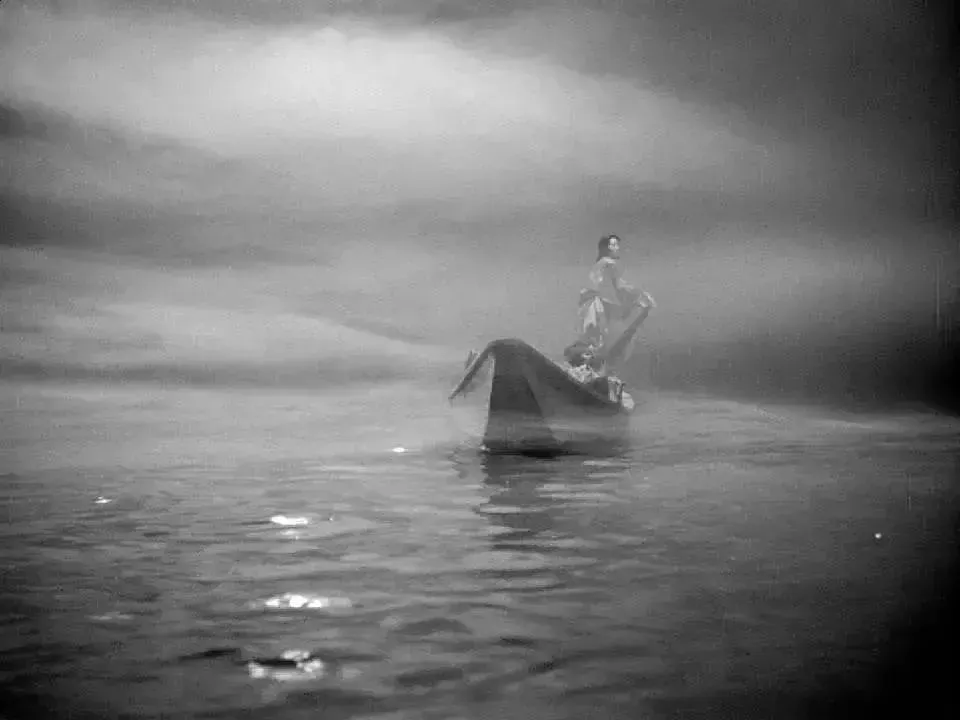
Parallel Plots and the Price of Ambition
Like a Jacobean drama, the film’s plot divides into a main plot and a subplot, with each potter taking center stage in their respective narrative. Both plots are variations on the same theme, mirroring each other in many ways. Broadly speaking, they both depict how men are seduced by idealized visions of perfection, how they achieve it through deception, and how, upon discovering the falsity of the ideal, they must pay a heavy price for their ambition and dishonesty.
In the subplot, for example, war ignites in Tobei a burning desire to become a samurai, to live the life of a regular soldier. In town, he is able to realize his ambition, for by selling the pots he earns enough gold to buy himself a suit of samurai armor. Fortune smiles upon him: by chance, he becomes the sole witness to the beheading of a warlord. Tobei steals the dead man’s head, somewhat timidly stabs the executioner in the back, and then trots off to a rival warlord, presenting him with the severed head. It is an astute move. Tobei is immediately hailed as a hero by the army and appointed captain.
Thus, he achieves his humble ambition. The price he pays is that his abandoned wife falls prey to other samurai. She staggers across the plains and is accosted by four ruffians, who drag her into an empty palace and rape her.
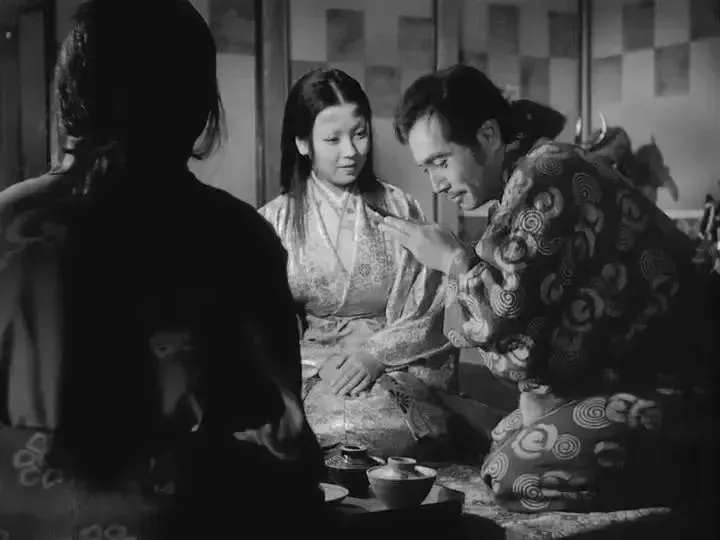
Mizoguchi presents a series of contrasting shots here – the scene of gold scattered over the raped Ohama mimics the scene of Tobei paying for his services – to show how marital affection has been debased by the husband’s ambition. There are other, more abstract similarities. In Ugetsu, the effects of both war and money are presented as similarly disastrous, though Mizoguchi never explains what causes what.
Later, in a moment of acute distress, Ohama, now a prostitute, chances upon Tobei in a geisha house and asks him to buy her services. On the prows of two stranded canoes, they reach a reconciliation: Tobei agrees (I find his gullibility a little incredible) that the two of them should return to the pottery kiln, in the hope that all, as Ohama puts it, “our suffering has not been in vain.”
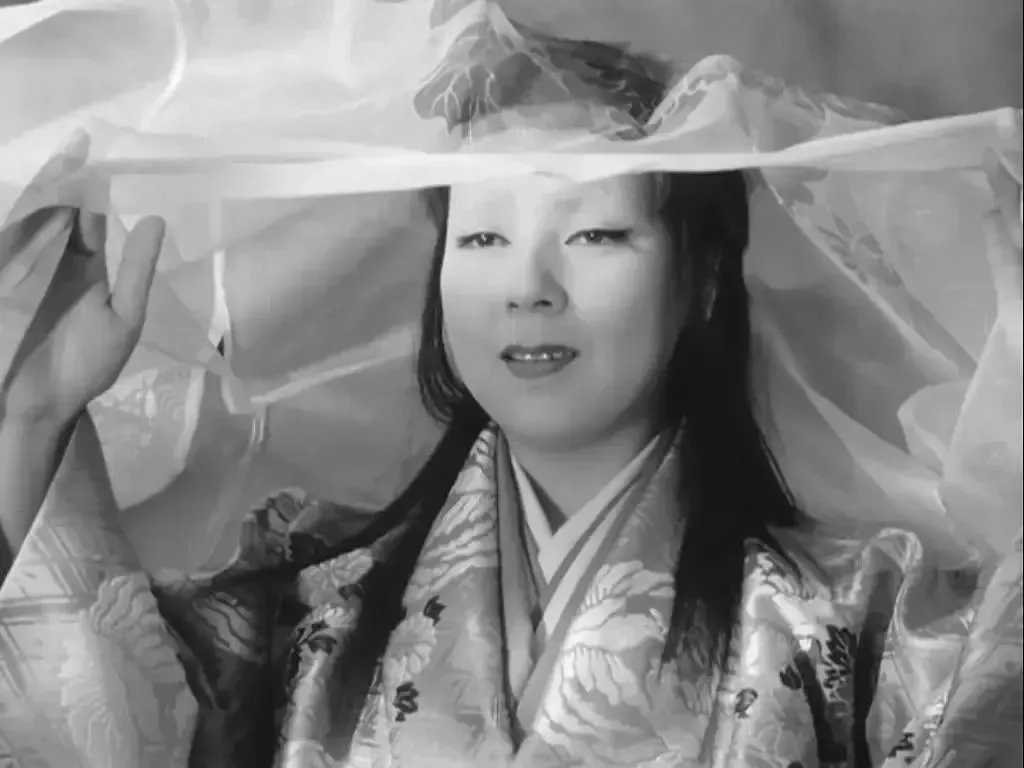
The Allure of the Supernatural
This powerful subplot is woven into the finer texture of the main plot, which, on the surface, tells a quite different story. While selling his wares in the market, Genjuro is approached by two women. One is a beauty, like a crane, Wakasa, and the other is an elderly servant, who asks Genjuro to deliver his large consignment of goods to Wakasa’s house. Genjuro, captivated by the noble lady, readily agrees.
In her magnificent castle, the desperation in their desires becomes apparent: while he wishes to possess the lady’s perfection, she wishes to learn the secrets of his art. Both desires are impossible and, in a sense, dangerously suggestive. Yet Genjuro is so entranced by the world he has entered that he does not realize how sinister it is. Mizoguchi subtly creates this atmosphere of doom, as Wakasa sings to the potter:
“The finest silk, the finest dye; may change and disappear; just like my life, dear; if you could prove that all is vanity…”
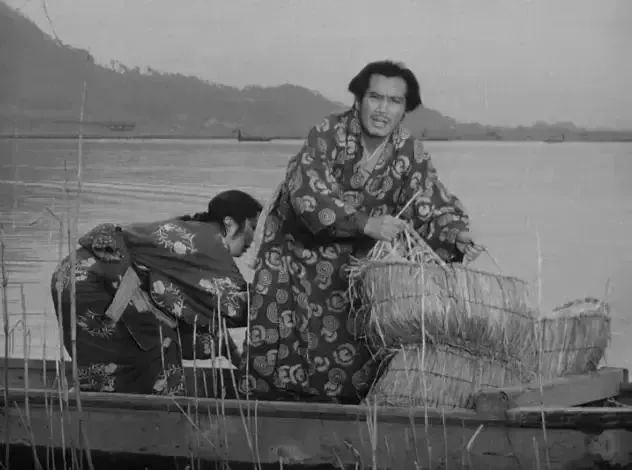
As she sings these words, the camera pans rapidly around the room, and a low, coarse laugh emanates from a dark samurai mask. The servant tells Genjuro that the laughter comes from the lady’s dead father, thus hastily explaining the strange sound – the deceased father is expressing his approval of his daughter’s lover in a unique way. The noble lady then proposes marriage to Genjuro; Genjuro, having left his wife behind, happily agrees.
The ensuing love scenes are as stylized as Hokusai prints. First: a rocky pool, where the lovers glide towards each other in misty steam. Then, they chase each other across a beautiful lawn, their robes billowing in the wind. Anxious close-ups of faces are followed by long shots of them embracing. Yet, even as this dalliance proceeds, Genjuro is paying the price for his idyllic love. His wife, returning from the lake, is abducted by robbers and killed for a few loaves of bread.
Disillusionment is at hand: a monk tells him that since Wakasa is a ghost, he will be dragged into the gates of the dead if he does not abandon her. The confrontation begins. The servant admits that the lady is not real, for neither are they. She is the ghost of a girl who died young and has returned to this world to seek the love she was denied. Suppressing a flicker of pity, Genjuro picks up a sword and drives the ghosts out of the castle. In the process, he accidentally falls over. When he comes to, he finds that the castle has turned into a charred ruin, as it has been for many years. Clearly, he has entered the world of the dead. “The finest silk fades,” sings a familiar voice. Perfection is unattainable; all is a dream.

Reconciliation and the Reverence for Life
As dusk falls, Genjuro returns to his family, begging for their forgiveness. Yet, he is still living in a fantasy. The next morning, a neighbor tells him that his wife is dead and must have been a ghost who took him back. The two plots now converge once more, and Genjuro and Tobei return sadly to their original kiln. Yet all is not lost, for Ugetsu aims to show that one must understand how illusion becomes part of reality.
As Genjuro works at his pottery, he hears the voice of his dead wife, telling him that she will always be with him and that her memory will be his inspiration. Thus, with these words, piety has been re-established, and the theme has been realized. As Genjuro’s child lays flowers on his mother’s grave, Mizoguchi cranes the camera so that we can see, in the distant fields, two men tilling the soil. The master ends this masterpiece with this inverted cadence.
The Western Perspective on the Supernatural
In the West, we tend to be defensive about the supernatural. Though our appetite for it is clear from the spate of films about vampires and outer space, no one considers this appetite to be respectable. Our typical response to such works is ambivalent: though we may enjoy them and call ourselves addicts, we still feel a slight sense of guilt, talking about them as if we were victims of some fashionable vice.
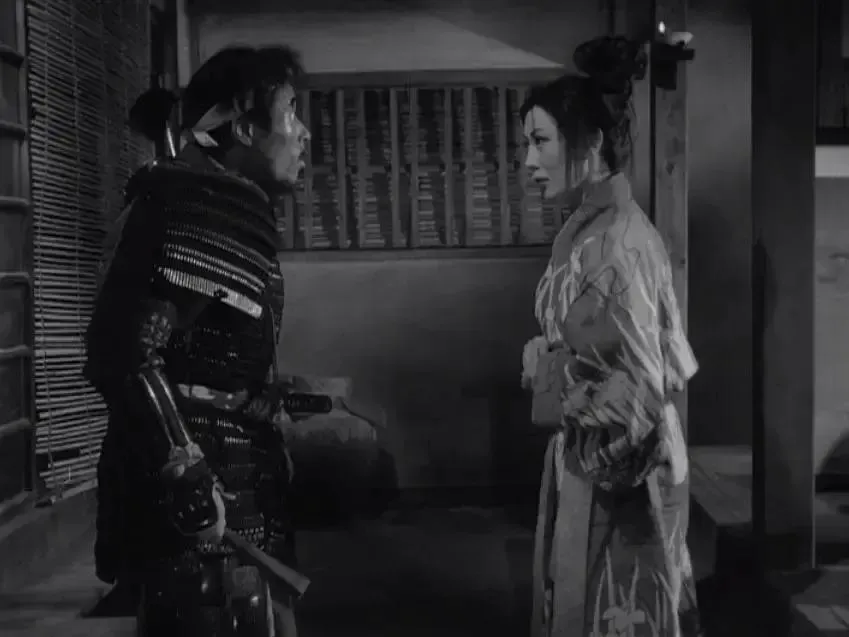
For the same reason, the intentions of the creators of such films are as ambivalent as our responses; their treatment of the supernatural is often both deceptive and clumsy. In fact, this type of film is the most difficult to make, and it is hard to imagine any top director in the West (perhaps Georges Franju is an exception) thinking of risking his reputation by making such a film. If one of them happened to want to do so, I very much doubt that he would treat the film’s themes as seriously as Kenji Mizoguchi does.
Why is this so? We do not lack literary material. In English literature alone, the Mallory legends, The Lord of the Rings, the Arthurian legends, and Sir Gawain and the Green Knight all have potential film ideas. Why don’t producers film them? (Note: This article was written in 1962.) I think the reason lies precisely in the fact that they are so awkward in dealing with this genre, which has to do with the way they look at reality. “Reality, as we conceive it, is external, hard, rough, unpleasant,” Lionel Trilling lamented in The Liberal Imagination.
While this accusation may no longer apply to the best novels written today, this limited concept of reality seems to remain ubiquitous in film and determines the structure of most films. For example, the techniques used to create characters. In most cases, these techniques are simple, schematic, and take no account of the individual’s inner world. Yet, human behavior is almost incomprehensible until we understand this inner world. For the fantasies that make up this inner world are the main content of unconscious psychological processes and condition the behavior of even the most “normal” people.
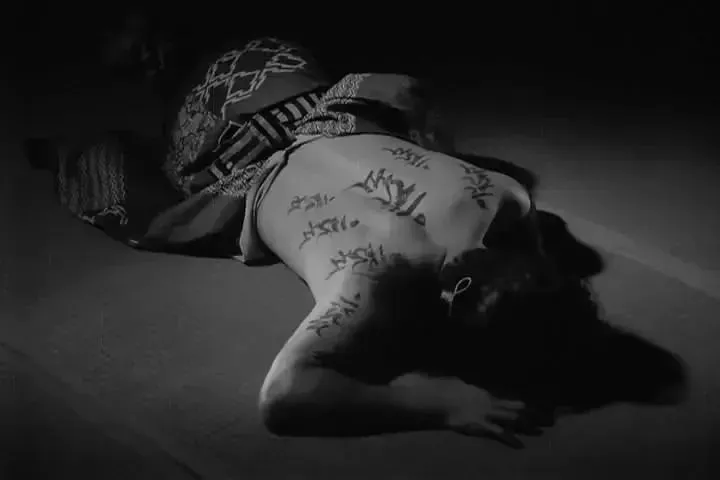
This may be what Ibsen meant when he said: “Life is a contest between the mind’s phantoms” – a statement that, I believe, goes a long way toward explaining why Ibsen’s realism has so much substance and why the tension between his characters can have such depth. Compared to this richness, the realism of many so-called realistic films seems so thin because these films do not take “mind phantoms” seriously enough. Since fantasy is an important part of the whole world, we long to make up for its loss, however indirectly.
Thus, if we cannot have pure realism, we can at least use vampires and flying saucers to make up for the normal fare of film. Mizoguchi, however, does not seem to be inhibited by this impoverished realism. The convention he uses – the allegory – enables him to create a world of reality for himself, in which such pressing issues as the fear of war and the lack of money become vivid and real, and a world in which a “mind phantom” is fully released. By doing so, he does remind us that these two worlds are interdependent.
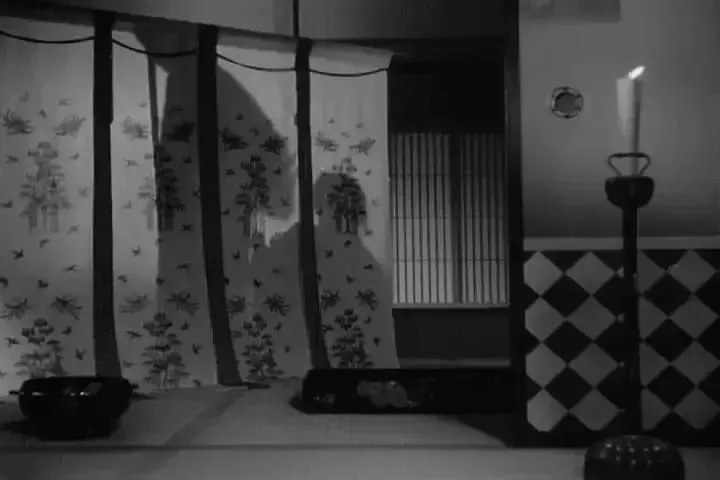
The Power of Allegory and Tradition
As I have said, Ugetsu is an incredible essay: that is, it retains the surface of everyday events while also creating a childhood world full of animism and fear, so that the characters’ predicaments are rich in naturalism, more ambiguous movements of thought. This dualism is established and maintained by Miyagi’s conservatism. For when she asks her husband to accept his fate and ignore his ambitious desires, she is, in fact, expressing the theme on which Mizoguchi’s films are usually based. Life, for her, as for the English politician Edmund Burke, is a contract signed between the dead, the living, and the unborn; therefore, our responsibility is not to rebel against the image of our parents, but to accept tradition and respect the dead.
In the context of this theme, the customs of ghosts become justified, as they represent the way in which the past and all its phantasmagoric memories, desires, and history play an important role in the present and give it meaning. Whether we abhor this conservatism or not, we must admit that it gives Mizoguchi the opportunity to vividly recognize many things about the nature of inspiration, the interplay of motivation and ideals, and the importance of piety – a series of humanistic truths (“reverence for life”).
It is worth noting that one of the best humanistic films, Kon Ichikawa’s The Burmese Harp, is an allegorical work with the same theme as Ugetsu. The paradox is that liberal humanism may only work under these conservative conditions.
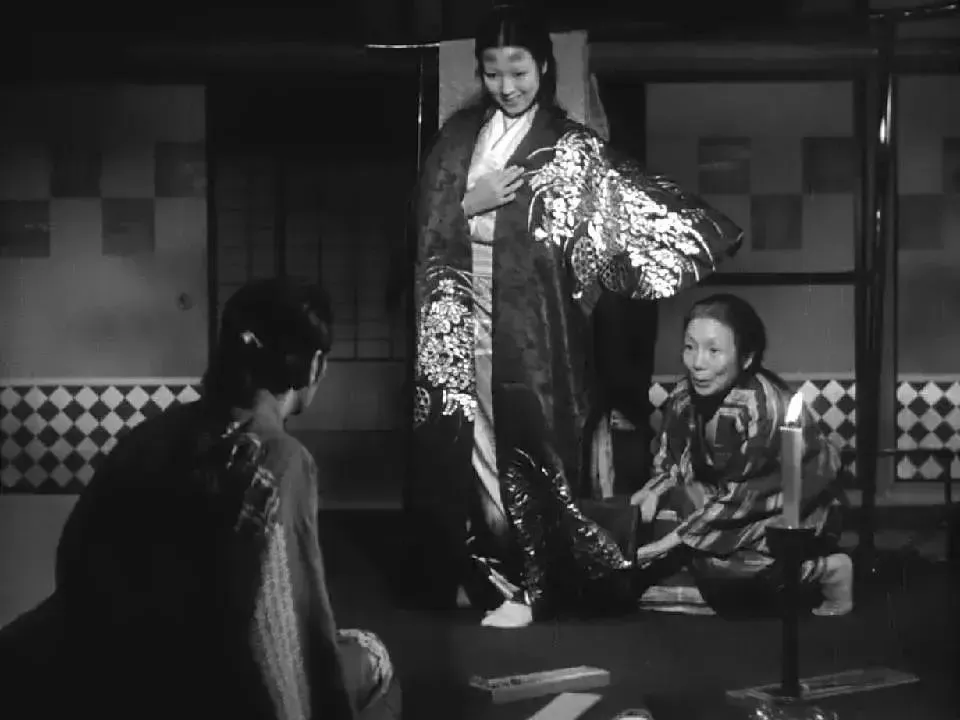
Unsurprisingly, the realism of Ugetsu is closer to that of ancient Greek drama, which is no accident. Mizoguchi relies on Noh drama – both the type of plot in his films and the style of his compositions. As the poet Ezra Pound has pointed out, Noh drama has similarities to ancient Greek drama and Shakespearean drama; for all of these are successors to the “miracle play.”
From the role of its imagery and its dual plot, Ugetsu’s presentation is Shakespearean (Mizoguchi uses the symbol of war, just as Shakespeare uses the symbol of the storm); like ancient Greek tragedy, its ghosts play the same role as the gods in Greek mythology, and its unity is built on a single moral conviction.
Furthermore, I believe Mizoguchi would agree with Aristotle that “a work of art should be an imitation of the mind, not a sorting of facts”; for it is in this sense that his view of realism is timeless.